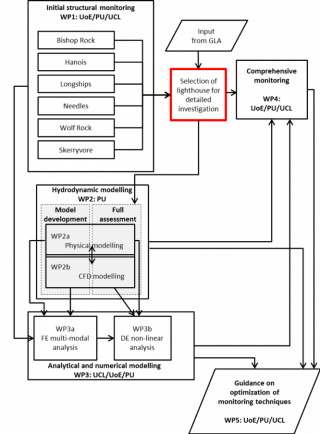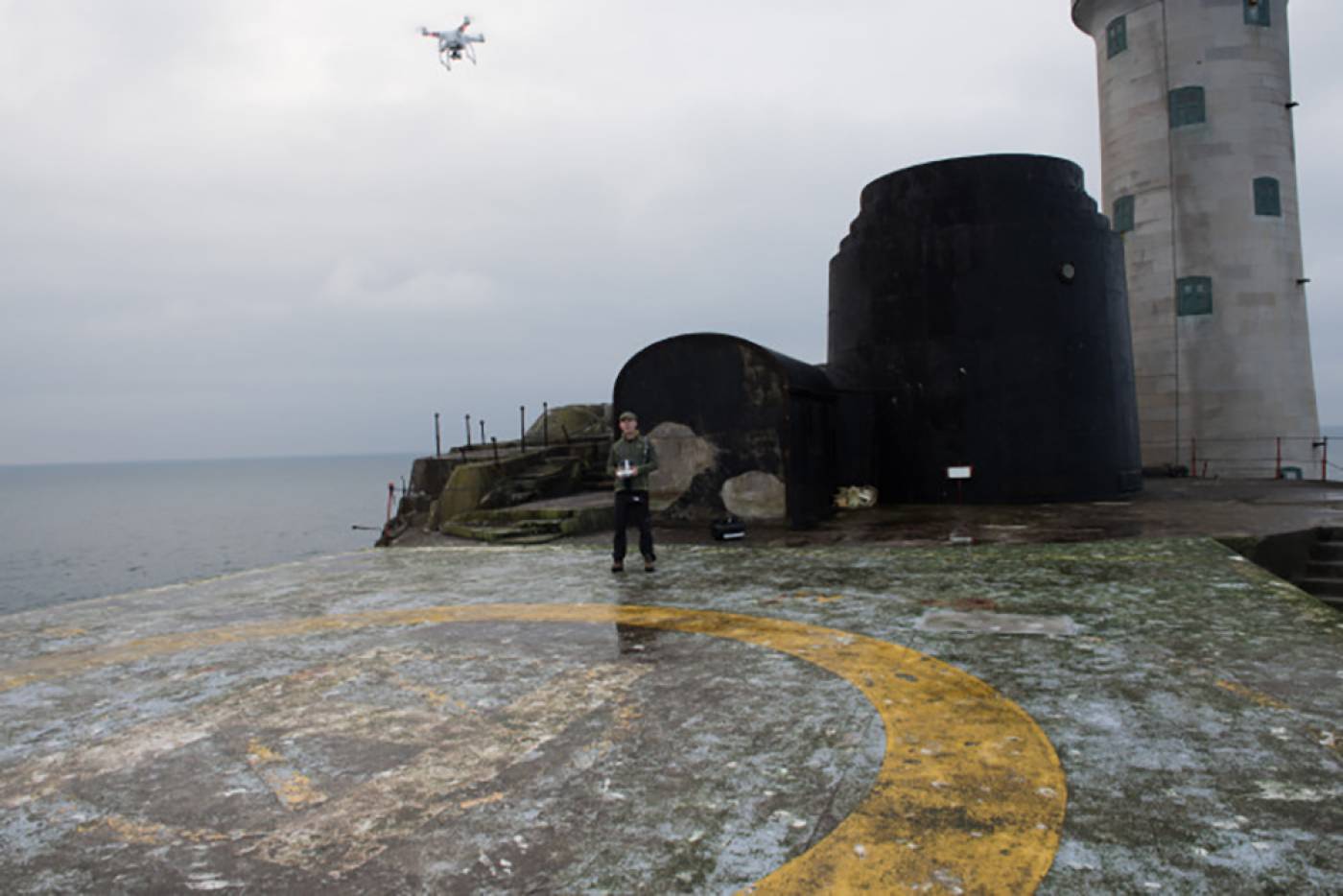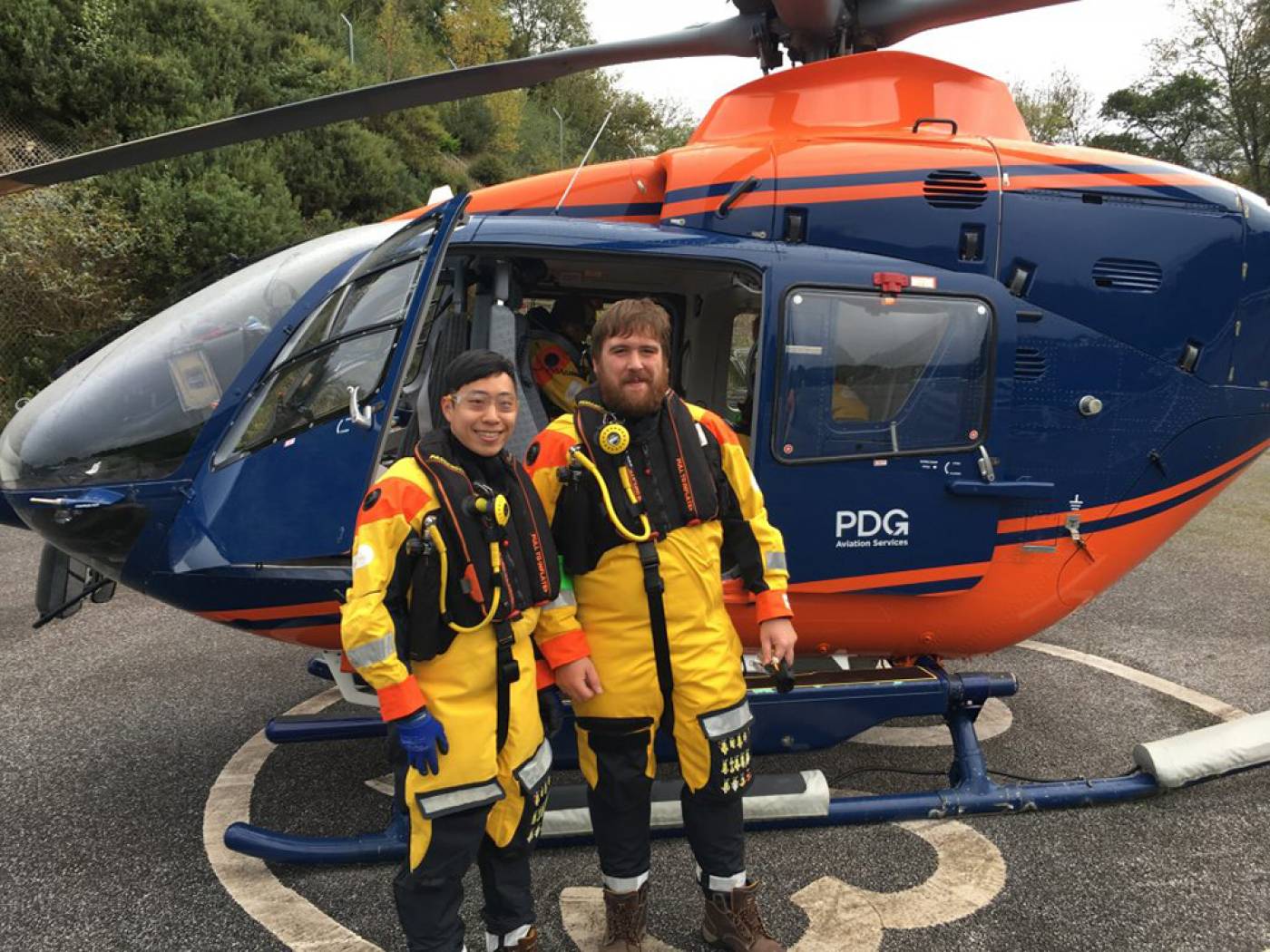STORMLAMP
Lighthouses are essential for the safety of mariners in navigating at sea, but after centuries of storms, weather and waves, are they still fit for purpose?
28 February 2020
About
The STORMLAMP project was a comprehensive EPSRC-funded project focusing on the structural performance of rock mounted lighthouses to wave loading. The four year project commenced in May 2016 and was a unique collaboration between University of Plymouth, University of Exeter and University College London and industry partners.
The project has entailed: fieldwork to characterise structural behaviour of the lighthouses and associated long-term monitoring of their response to being impacted by waves; experimental testing to characterise the wave impacts in the Plymouth COAST Laboratory Ocean Basin alongside CFD modelling; and detailed structural assessment of historic lighthouses modelled following an in-depth study of original nineteenth century drawings.
End of Project Workshop
An online webinar was held to mark the end of the project on Wednesday 13th May 2020. The event involved presentations on lighthouse research and relevant areas from academics, heritage professionals and industry stakeholders. Presentations can be viewed below.
Project Structure
- Project structure flow chart
The flow chart indicates work packages (WPs) undertaken by project partners.

Project Partners
- University of Plymouth
Plymouth University was the lead partner of STORMLAMP. In addition to ensuring successful delivery of the project objectives Plymouth had responsibility for hydrodynamic modelling of the wave environment that was used by the structural modellers at UCL. The modelling comprised of physical tests on small scale models in the COAST Laboratory at the university in addition to sophisticated Computational Fluid Dynamics modelling. Plymouth University also contributed to fieldwork, STORMLAMP being based upon the earlier pilot project on the Eddystone lighthouse. The team comprised of Dr Alison Raby, Professor Deborah Greaves, Dr Darshana Dassanayake, Dr Alessandro Antonini and Dr Ed Ransley. Main point of contact was Alison Raby – alison.raby@plymouth.ac.uk.
- University of Exeter
The Exeter team was responsible for field measurements for dynamic assessment and long term monitoring. Modal analysis of data from the dynamic assessments identified dynamic characteristics of the lighthouses which were used to calibrate the structural models developed by UCL. The models were used with the long term monitoring data to characterise wave loads on the structures.
- University College London
UCL created a sophisticated multi-scale numerical simulation of the lighthouses that was used with the data gathered on site to create long-term diagnoses. The numerical structural model was also linked with advanced physical modelling at Plymouth University’s COAST Laboratory, and numerical (computational fluid dynamic) simulations.
Professor Dina D’Ayala, of UCL Civil, Environmental and Geomatic Engineering, said: “The six lighthouses which will be studied during the STORMLAMP project form part of an historically critical network around the British Isles that must be maintained. This project will play a key role in developing our understanding of how we can increase their lifespan against the increased storminess caused by climate change. The opportunity to directly study the impact of waves on these coastal structures will also allow this knowledge to be applied to protecting a range of other coastal defences.”
- Trinity House
The Corporation of Trinity House of Deptford Strond is a private corporation governed under a Royal Charter, responsible for the provision and maintenance of navigational aids, such as lighthouses, lightvessels, buoys, and maritime radio/satellite communication systems. Trinity House’s world-famous lighthouses are often sited in spectacular locations, performing a vital role in the safety of mariners in all weathers
Trinity House maintains over 60 lighthouses around England, Wales, the Channel Islands and Gibraltar. These highly visual aids to navigation range from isolated offshore towers exposed to the open sea – such as Eddystone, Bishop Rock or Longstone lighthouses – to shore-based stations with cottages and gardens in some of the nation’s most beautiful locations, such as Lizard, Bardsey, Nash Point and Peninnis lighthouses.
Amongst their assets is Eddystone Lighthouse, where the university of Plymouth evaluated the extreme logistical constraints of lighthouse operations and the feasibility of using instrumentation to understand the response of the lighthouse to wave loads.
- Irish Lights
Irish Lights are a maritime organisation delivering an essential safety service around the coast of Ireland, protecting the marine environment, and supporting the marine industry and coastal communities. They are responsible for providing marine aids to navigation (AtoN) under the Safety of Life at Sea (SOLAS) convention.
Their AtoN include radio aids such as Differential GPS (DGPS), Radar Beacons (Racon), and Automatic Identification Systems (AIS), as well as more traditional visual aids such as lighthouses, buoys and beacons.
These AtoN complement Global Navigation Satellite Systems (GNSS), such as GPS, which are the primary means of navigation for most mariners. If satellites are not available, these AtoN provide position, spatial awareness, hazard marking and backup. Lighthouses on the coast of Ireland managed by Irish Lights were featured in the research undertaken by STORMLAMP.
- Northern Lighthouse Board
The Northern Lighthouse Board is the General Lighthouse Authority for Scotland and the Isle of Man. It provides marine navigation aids to assist the safe passage of mariners through waters in these areas. It is also responsible for marking and dispersing wrecks which are a danger to navigation.
The board is based at its Georgian headquarters building in George Street in the centre of Edinburgh, from where it remotely monitors its network. Technical operations are carried out from bases in Oban, Argyll and Bute, where there are maintenance workshops and facilities for the construction of buoys and beacons. The NLB’s vessels are also based here.
Lighthouses on the coast of Scotland managed by The Northern Lighthouse Board were featured in the research undertaken by STORMLAMP.
- HR Wallingford
HR Wallingford is an independent civil engineering and environmental hydraulics organisation. It was founded as the Hydraulics Research Station.
The Hydraulics Research Station (HRS) was created by the UK Department of Scientific and Industrial Research in 1947. The Research Station was based in Wallingford, near Oxford. It was established to deal with “looser boundary” problems such as coastal erosion, flood protection and the silting and scouring of rivers, estuaries and harbours. The Hydraulics Research Station was housed at Howbery Park as a government establishment until 1982, when it was privatised from the Department of the Environment (DoE) to become Hydraulics Research Station Limited. It is now known as HR Wallingford. During its existence, HRS contributed to advance hydraulics research. It also worked on water-related projects in the UK and around the world.
HR Wallingford support PhD and Visiting Researcher studies on closely related topics. Our CFD researcher spent time at HR Wallingford collaborating on CFD models to simulate wave-structure interaction processes. HR Wallingford provided support in reviewing papers and technical discussions.
- AECOM
AECOM is an American multinational engineering firm that provides design, consulting, construction, and management services to a wide range of clients.
AECOM have worked with Trinity House for many years on projects extending to over 25 lighthouses in England, Wales, Gibraltar and the Channel Islands. They made an important contribution to different elements of the project and brought invaluable expertise.
- Atkins
WS Atkins plc (commonly known as Atkins) is a British multinational engineering, design, planning, architectural design, project management and consulting services company headquartered in Epsom, Surrey. It was founded in 1938 by Sir William Atkins.
As of 2016, Atkins is UK’s largest engineering consultancy and the world’s 11th largest global design firm. It employs approximately 18,000 staff based in 300 offices across 29 countries and has undertaken projects in over 150 countries. Its motto is “Plan, Design, Enable”.
- Environment Agency
The Environment Agency (EA) is a non-departmental public body, established in 1995 and sponsored by the United Kingdom government’s Department for Environment, Food and Rural Affairs (DEFRA), with responsibilities relating to the protection and enhancement of the environment in England (and until 2013 also Wales).
The Environment Agency’s stated purpose is, “to protect or enhance the environment, taken as a whole” so as to promote “the objective of achieving sustainable development” (taken from the Environment Act 1995, section 4). Protection of the environment relates to threats such as flood and pollution. The vision of the Agency is of “a rich, healthy and diverse environment for present and future generations”.
The Environment Agency’s remit covers the whole of England, about 13 million hectares of land, 22,000 miles (35,000 km) of river and 3,100 miles (5,000 km) of coastline seawards to the three-mile limit which includes 2 million hectares of coastal waters. In a sharing arrangement with the Scottish Environment Protection Agency (SEPA), it also exercises some of its functions over parts of the catchments of the River Tweed and the Border Esk which are, for the most part, in Scotland.
The Environment Agency is particularly interested in the mechanisms associated with degradation of historic coastal masonry assets under chronic and acute wave loading. They have programmed investment of £2.3 Billion on Flood & Coastal Erosion Defences over the next 6 years and much of this will involve repair and rehabilitation of existing masonry structures which are subject to this type of wave loading. The Environment Agency contributed to STORMLAMP by providing access to data and historical records relating to field sites, as well as ad-hoc advice
Publications
- 2019
Brownjohn, J., Raby, A., Au, S., Zhu, Z, Wang, X., Antonini, A., Pappas, A., D’Ayala, D. (2019) Bayesian operational modal analysis of offshore rock lighthouses: Close modes, alignment, symmetry and uncertainty. Mechanical Systems and Signal Processing, 133, 106306.
Au, S.K., Brownjohn, J.M., Li, B. and Raby, A., Understanding and managing identification uncertainty of close modes in operational modal analysis. Mechanical Systems and Signal Processing, 147, p.107018.
- 2018
Antonini, A., Raby, A., Brownjohn, J., Pappas, A., & D’Ayala, D. (2018). Survivability assessment of Fastnet lighthouse. In 36th International Conference on Coastal Engineering ICCE-2018. Baltimore
Antonini, A., Raby, A., Caputo, P., Brownjohn, J., Pappas, A., & D’Ayala, D. (2018). An integrated approach for marine structures survivability assessment: the Fastnet lighthouse within the STORMLAMP project. XXXVI Convegno Nazionale di Idraulica e Costruzioni Idrauliche Ancona, 12-14 September 2018
Brownjohn, J., Au S., Wang X., Zhu Z., Raby, A., & Antonini, A. (2018). Bayesian operational modal analysis of offshore rock lighthouses for Structural Health Monitoring. The 9th European Workshop on Structural Health Monitoring, 10-23 July 2018. United Kingdom
Pappas, A., D’Ayala, D., Antonini, A., & Raby, A. (2018). Rock mounted iconic lighthouses under extreme wave impacts: Limit Analysis and Discrete Element Method. The 9th International Conference on Computational Methods (ICCM2018) – Rome, Italy.
Pappas, A., D’Ayala, D., Antonini, A., & Raby, A. (2018). Finite element modelling and limit analysis of Fastnet lighthouse under impulsive ocean waves. The International Conference on Structural Analysis of Historical Constructions (SAHC 2018) – Cusco, Peru.
Brownjohn, J., Raby, A., Bassitt, J.,Antonini, A., Hudson, E., & Dobson, P. (2018). Experimental modal analysis of British rock lighthouses. Marine Structures, 62, 1–22. https://doi.org/10.1016/j.marstruc.2018.07.001
- 2017
Brownjohn, J., Raby, A., Bassitt, J., Hudson, E., & Antonini, A. (2017). Modal testing of offshore rock lighthouses around the British Isles. Procedia Engineering, 199, 3326–3331. http://doi.org/10.1016/j.proeng.2017.09.440
Pappas, A., D’Ayala, D., Antonini, A., Brownjohn, J., & Raby, A. (2017). Numerical modelling of Fastnet lighthouse based on experimental dynamic identification. In International Conference on Advances in Construction Materials and Systems ICACMS-2017. Chennai.
Images

Left to right: Alison Raby (Plymouth), Dassa Dassanayake (Plymouth), Peter Dobson (Trinity House) conduct wave impact tests in the COAST Laboratory at University of Plymouth.

Wave impact tests with 1:40 scale model of Wolf Rock lighthouse conducted in the Ocean Basin in the COAST Laboratory at the University of Plymouth

James Bassitt operates a Phantom drone from the helipad of Fastnet Rock, to collect aerial footage at medium and close range.

Camera system on Wolf Rock lighthouse.

FEM (Finite Element Method) analysis of wave impacts on Fastnet Lighthouse.

1860 elevation and section drawing of Wolf Rock, copyright Trinity House.

Alessandro Antonini (University of Plymouth) and Vincent Ao (University of Exeter) ready to carry out modal test of Eddystone Lighthouse.
 Close
Close

